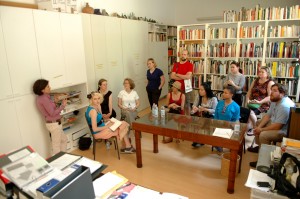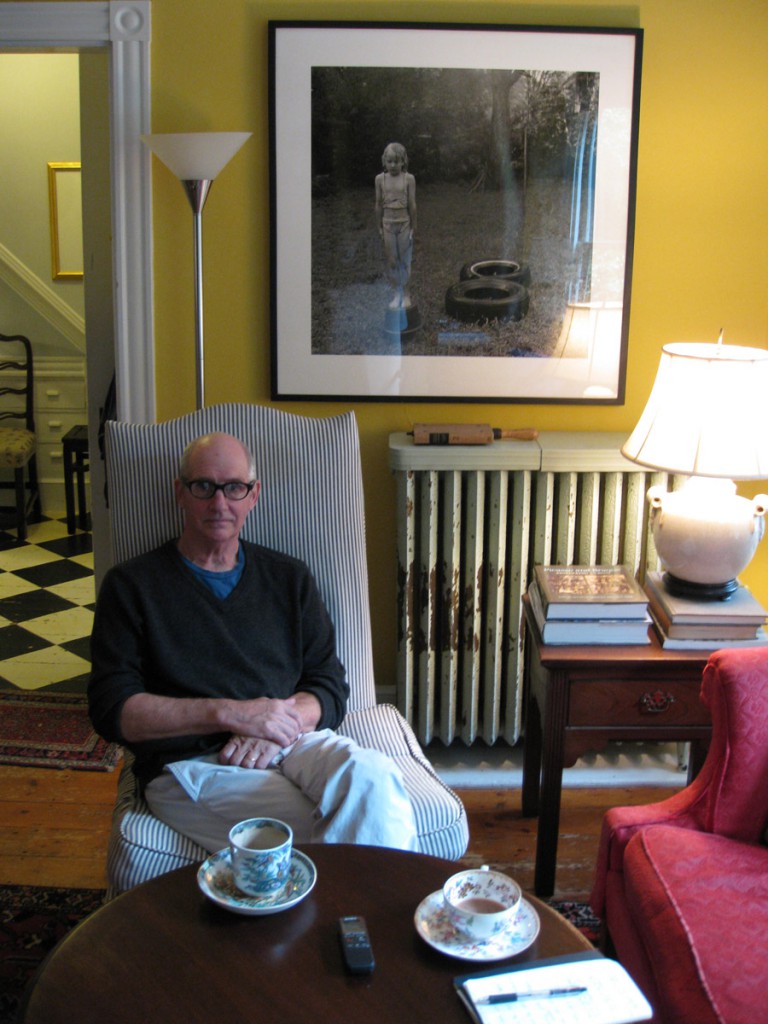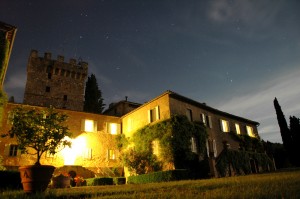
I suspect most people today would agree that making art involves more than technical skill. By the seventeenth century, the intellectual and philosophical side of artistic expression had already been institutionalized in “academies,” which broke from the guild system of instruction. Even the word “academy” asserted that art was a serious mental pursuit that deserved schools like those of any other humanistic discipline.
Unlike other disciplines in the humanities, however, visual art has carried on without doctoral degrees, at least until recently. When George Smith founded the Institute for Doctoral Studies in the Visual Arts (IDSVA) in 2007, the program had few peers. While the number of PhD programs in art has grown significantly since then, IDSVA remains unique for its emphasis on theory and philosophy. Notably, the program does not include any studio work. Instead, reading, writing, and on-site discussions in the world of art form the basis of the low-residency school, which convenes for intensive sessions in Europe and the United States. I recently met with Smith at his home in Portland, Maine to talk about IDSVA and the basic question of whether artists need PhDs.
Oliver Wunsch: I understand that IDSVA offers no studio instruction, but theory plays a major role in the program. As a way of beginning, could you talk about the reasoning behind this format?
George Smith: If the way an artist sees the world changes, if her range of perception broadens and deepens, then her artistic ability, her ability to represent history, human consciousness, the history of aesthetic discourse, this will change for the better because she will have changed for the better. In other words, the studio practice gets taken to the next level because the artist who goes into the studio has developed intellectually, spiritually, and as a citizen of the world. In my experience as a teacher of artists, the rigorous study of theory and philosophy can make that happen. But IDSVA is not just about making better studio artists; we’re trying to produce artist-philosophers.
OW: Does that experience need to be called a PhD? Why not just invite qualified people who want to do this sort of thinking, reading, and writing, without the doctoral degree?
GS: The PhD requires a measure of rigor that cannot be imposed upon people who are just stopping by for a conversation. For one thing, you have to write a dissertation and that dissertation has to be submitted to professional review. Writing to an audience of that kind is a tremendously important aspect of the experience. But more to the point, we want IDSVA graduates to go into universities and colleges and teach. We want them to lead the discussion that is shaping the future of American intellectual discourse, not just in visual arts, but in the humanities and in other disciplines as well. And to do that, they have to be credentialed.
OW: Right now, you can become a professor of studio art with an MFA. With a PhD, your graduates presumably would be able to teach not just studio practice, but also theory, philosophy, and so forth…
GS: Exactly.
OW: Why shouldn’t those artists simply get a degree in the subjects that seem relevant to their work? For instance, if psychoanalytic theory means something to your art, shouldn’t you just study in that field?
GS: The answer to your question is partly practical. If you have an MFA and want to go to someplace like the University of Chicago for a PhD in the history of psychoanalysis, they’ll probably say go back and do your MA first. IDSVA grants credit to the MFA for a humanities PhD. More importantly, though, we’re putting together an intensive collaboration. Most IDSVA students hold an MFA and many are studio faculty. Maybe half are tenure track, many are full-professors, and some are department heads. About a third are adjunct professors looking to strengthen their academic position. Others are curators or creative intellectuals with an MA in cultural studies or art history. We love the dialogical mix. The common thread is that most everybody at the table sees the world through the relationship of the hand, the eye, the body, and space, and they resolve abstract problems from that experiential standpoint as opposed to a purely abstract view.
OW: All of that makes sense, but I wonder if there’s a danger that you won’t ever really be in dialogue with the traditional scholars who specialize in the subjects that you’re studying. Do you worry about separating yourself from the people whose ideas you’re borrowing?
GS: We want to cultivate a space in which artists and creative thinkers can grow and develop as artist-philosophers, but also where all kinds of artists and scholars can gain from the process. For instance, someone like Stephen Greenblatt, a leading Renaissance scholar from Harvard University, comes to lecture for us at Spannocchia Castle in Tuscany and leaves deeply affected by the experience. We’re not looking to balkanize ourselves as some group of artists who are now going to take over the world from the standpoint of theoretical advancement. The point is to open up a discussion in a way that allows people like Greenblatt to hear what an artist-philosopher has to say about the Renaissance. Of course the artist-philosopher has a pretty wide-eyed appreciation of what Greenblatt’s saying, too, and it’s the exchange that makes the conversation so rich and productive.
OW: Could you say more about the locations where the program meets, what goes on, and how these activities relate to the setting?
GS: I mentioned Stephen Greenblatt because his participation as IDSVA Visiting Faculty typifies our pedagogical approach in an important way. When Stephen lectures on the transition from Feudal to Renaissance to postmodern consciousness, for historical context he’s using Spannocchia Castle, which has been restored to its origins as an agrarian estate, and he’s using the art and architecture of Siena, which is a nearby medieval banking city. Then we go up to Milan, where we look at Da Vinci’s Last Supper as a visual dramatization of Stephen’s cultural critique, and afterwards we go across town, to a little-known cathedral that houses a Dan Flavin installation, and ask ourselves, “Okay, what’s the relation between Stephen’s lecture, Leonardo’s representation of Renaissance thought, and Flavin’s projection of light in a fifteenth-century Milanese church?” From there we go to Paris, where Étienne Balibar, the preeminent French Marxist, picks up the thread with John Rajchman and they talk about their new book on postmodern French philosophy and what they and others are calling “the contemporary.” In Januar,y it’s on to Harlem and Manhattan, where Jim Elkins, Julie Mehretu (Art21 Season 5), Simon Critchley, and Avital Ronell will push the question of the contemporary from within the framework of post-industrial urban space. Next June, we’ll be at the Venice Biennale. In years to come we hope to be in Berlin, Beijing, São Paulo, and Cape Town.
OW: The second portion of the program involves the dissertation, which I wanted to ask you about, but in a somewhat roundabout way. I read that you started out pursuing poetry. Since poetry merges textual communication and artistic expression, I wondered whether this early experience influenced your interest in seeing artists write PhD theses. Specifically, how do you see the dissertation in relation to creative expression? Do you consider the writing that comes out of the program to be art? Or is it totally separate from the artistic practice of your students?
GS: From writing poetry, I learned how to write prose criticism. And what I learned was that it’s arduous labor. It’s not a matter of inspired spontaneous expression. I don’t ever want a search committee to say of a job applicant from IDSVA, “Well, they’re writing on their own art,” or, “this creative expression of the artist’s relationship to the work of art lacks theoretical rigor.” Hence IDSVA students refrain from writing on their studio practice, especially in the dissertation. We have a lot of artists coming in who see their relationship to language—particularly abstract, philosophical language—as their weakest link. Through a very tough transformative learning process, they make their weakest link as strong as their strongest one, which is the studio. What they come away with is the inspiration to give those now inexhaustible powers to others—through their art, their teaching, their critical thinking and writing. If we said, “You’re not going to be like other scholars; you’re going to get the easy version where you can write about yourself or write non-critical prose,” we’d be selling everybody short.

IDSVA students with Professor Sharon Hecker at the studio/archive of Luciano Fabro in Milan. Photo: Nil Santana
OW: I’m surprised to hear you say that many of your students enter the program thinking that they have a weak relationship with language. Somehow I just assumed that you would only attract artists who already felt very confident about dealing with theoretical texts. What type of student makes a good match for IDSVA?
GS: It runs up and down the spectrum. Those who come in thinking that theory and philosophy are of less interest than career development often get drawn so deeply into the program of study that they wind up in a very different place. There’s no one type. I’ll say that there’s a general consistency in that even those who are “up” on theory make it plain that they’re not at IDSVA to primp their version of theory and philosophy. Most everybody comes wanting to know more and to share what they learn. It’s an amazing, incredibly generous, and intelligent bunch.
OW: If a student applies to the program and doesn’t feel especially grounded in theoretical thinking, then I wonder how do you figure out whether this person has potential. Do you see it in their studio practice? Do you find intelligence in works of art themselves?
GS: You figure out whether a person has potential through multiple interviews, writing samples, and looking at the work. But that’s hardly to say that every artist with an MFA should run out and apply to IDSVA. There are some, though—a tiny fraction of the total population of artists—who really want to understand theory and philosophy in relation to art and to themselves as practicing artists. IDSVA is a place in the world where artists and creative thinkers can go and do precisely that.






Pingback: Life After MFA…The PhD Option? | Art21 Blog